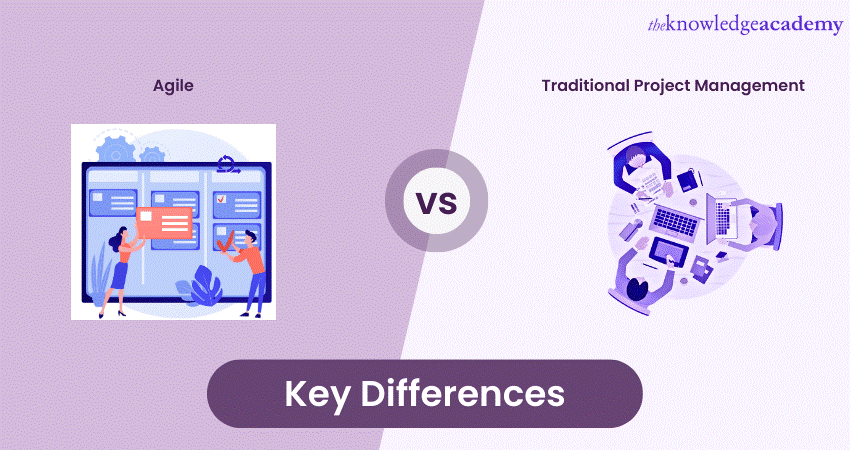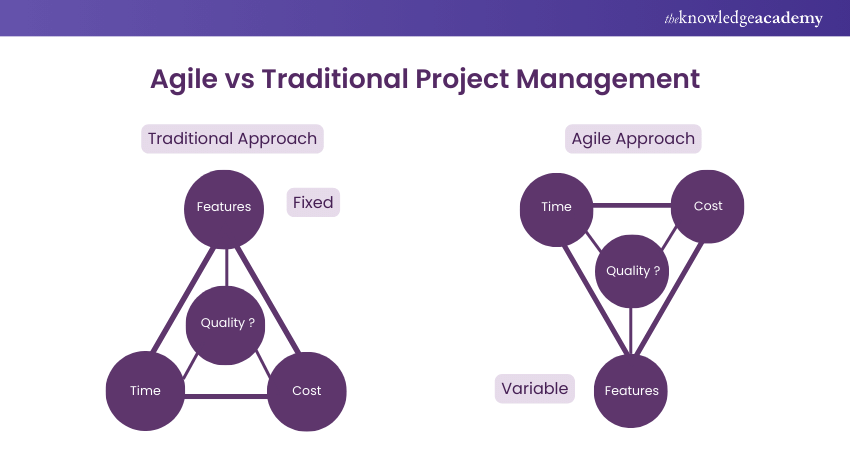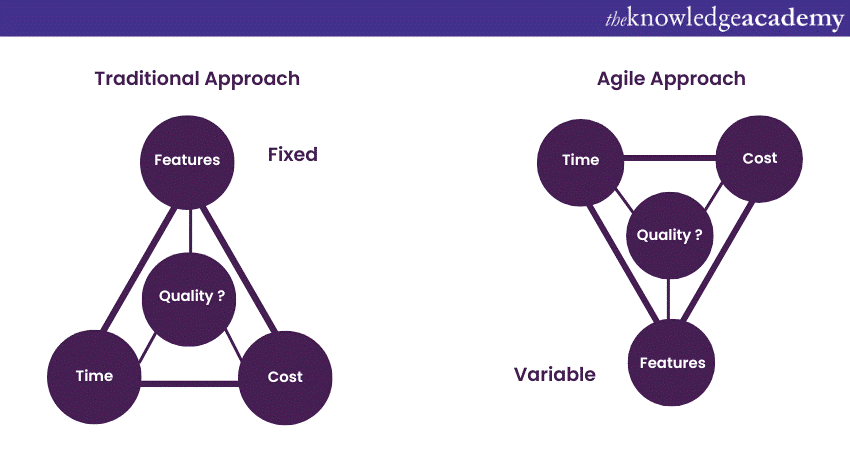We may not have the course you’re looking for. If you enquire or give us a call on +91 8037244591 and speak to our training experts, we may still be able to help with your training requirements.
Training Outcomes Within Your Budget!
We ensure quality, budget-alignment, and timely delivery by our expert instructors.

Project Management is a vast field, encompassing several tools and techniques. Out of the many techniques two techniques are the most popular and debated ones: Agile vs Traditional Project Management.
While, Agile emphasises flexibility and adaptability, allowing for iterative development and frequent stakeholder collaboration. The Traditional methodology follows a sequential process, focusing on detailed planning, documentation, and adherence to predefined schedules. Both these methodologies use different techniques to manage projects. Do you want to know Agile vs Traditional Project Management: What sets them apart? Well, you have come to the right blog.
Read this blog on Agile vs Traditional Project Management to learn about both methodologies, their differences and similarities, and how to choose which to use.
Table of Contents
1) What is Agile Project Management?
2) Advantages of Agile Project Management
3) Disadvantages of Agile Project Management
4) What is Traditional Project Management?
5) Advantages of Traditional Project Management
6) Disadvantages of Traditional Project Management
7) Agile vs Traditional Project Management: Detailed comparison
8) Agile vs Traditional Project Management: Key similarities
9) How to choose between Agile vs Traditional Project Management?
10) Conclusion
What is Agile Project Management?
Agile Project Management is an approach that prioritises effective teamwork, collaboration, and adaptability to deliver quality results. It promotes frequent customer feedback and continuous updates. This allows quick adjustments during each Software Development iteration.
Thus, gaining Certifications in Agile management highlight the importance of teamwork, customer collaboration, and flexibility. Agile methodologies are known for incorporating customer feedback and delivering continuous value through iterative development.
One of the key strengths of Agile Project Management is its adaptive planning. Unlike rigid, predefined processes, It embraces changes and focuses on delivering tangible outcomes. This flexibility has made it a preferred choice for Agile Project Managers worldwide.
Popular Agile Project Management Frameworks like Scrum and Kanban are widely adopted. These frameworks foster efficient decision-making and minimise unnecessary time spent on variables that are likely to change. Client satisfaction remains a top priority throughout the Project Management process, and teams are used effectively for continuous development.

Advantages of Agile Project Management
Here are some advantages of Agile Project Management:
a) Quicker time-to-value for customers
b) Efficient resource utilisation
c) Adaptability and responsiveness to change
d) Faster turnaround times
e) Rapid issue detection and resolution
f) Streamlined processes and reduced bureaucracy
g) Access to a supportive Agile community
h) Immediate feedback and improved team morale
I) Skill development based on quality assurance feedback
j) Focus on delivering functional solutions, not premature optimisation
k) Cost-effective experimentation and idea testing
Unlock your potential and drive your career forward with our SAFe Agile Certification!
Disadvantages of Agile Project Management
The following are some disadvantages of Agile Project Management:
a) Limited documentation, which makes it harder for new team members to catch up
b) Difficulty in measuring progress across iterative cycles
c) Increased time and energy demand due to continuous collaboration
d) Limited flexibility in resource allocation
e) Potential for indefinite project timelines without clear endpoints
f) Scope creep and potential degradation of experience
g) Uncertainty in cost and schedule predictability
h) Challenges in overall product design and cohesion
i) Neglect of technical debt and increased unplanned work
j) Limitations in accommodating large-scale features
k) Importance of long-term vision and effective communication
l) Challenges in maintaining product cohesion and user experience
m) Time constraints impacting design thinking and iterations
Ready to lead and drive success? Enroll in our Change Management Certification program to gain the skills and credentials you need.
What is Traditional Project Management?
Traditional Project Management is a well-established methodology that follows a sequential cycle, including initiation, planning, execution, monitoring, and closure. This approach emphasises linear processes, thorough documentation, upfront planning, and strict prioritisation. In the Traditional method, requirements are typically fixed while time and budget are variable, often leading to challenges in adhering to budgets and timelines. The widely recognised PMBOK® framework provides Project Managers with tools and techniques that guide each step of the process.
Another notable methodology within Traditional Project Management is PRINCE2, which is adopted by various organisations, including those under the UK government and private companies like Vodafone and Siemens. This methodology, often called the Waterfall model, follows a sequential flow where each stage is completed before moving on to the next.
The Traditional Project Management methodology includes:
a) Clear and well-defined objectives
b) A sense of ultimate control over the project
c) Comprehensive documentation
d) Increased accountability for all involved stakeholders
Traditional Project Management aims to ensure project success and deliver high-quality outcomes by following structured processes and focusing on detailed planning.
Advantages of Traditional Project Management
Traditional Project Management offers several advantages. Here are some the following points:
1) The Traditional methodology emphasises detailed upfront planning, which helps establish a clear roadmap and project scope. This provides a solid foundation for the project and helps ensure that everyone involved has a shared understanding of the project objectives.
2) It offers a predictable outcome. Its linear and sequential approach allows for better predictability in terms of timeline and deliverables.
3) Each project phase is defined and a review process. This makes sure that the mistakes are identified and corrected before the next phase starts.
4) In Traditional project Management there are detailed records of the entire project. This documentation can is beneficial for training, audits, and future projects.
5) Roles and responsibilities are clearly outlined. Hence all team members know exactly what kind of responsibility they have to carry out.
6) The structured nature of Traditional Project Management such as Waterfall, makes the process predictable. This predictibility helps in reassuring stakeholders.
7) Traditional Project Management helps in measuring the progress of each stage. This helps the projects to be on track.
8) It is quite popular and longstanding in various industries. This creates a familiarity between the stakeholders and team members.
Learn the basics of Agile Project Management with our Agile Project Management Foundation (AgilePM®) course. Join today!
Disadvantages of Traditional project Management
Traditional Project Management also has its disadvantages, that are as follows:.
Traditional projects are often less adaptable to changing requirements or unexpected events. This lack of flexibility can hinder the project's ability to respond effectively to changing circumstances, potentially leading to delays or the inability to meet evolving needs.
It allows limited customer involvement. Customer input and feedback are often limited to the initial planning stages, which may result in a misalignment between the final deliverables and the customer's expectations.
Due to its sequential nature, the phases in Traditional Project Management, like Waterfall, have to be completed before the next phase begins. This leads to longer project duration.
While documentation is vital, the traditional methods can sometimes prioritise paperwork over actual product development or problem-solving.
Agile vs Traditional Project Management: Detailed comparison
Agile vs Traditional Project Management techniques are two widely used methodologies for effectively managing projects. Let's look at the difference between Agile and Traditional Project Management:

|
Agile Project Management |
Traditional Project Management |
|
Iterative and incremental development approach |
Sequential and linear development approach |
|
Emphasis on flexibility and adaptability |
Emphasis on planning and execution according to a predefined plan. |
|
Customer satisfaction is a primary focus. |
Emphasises delivering defined project goals and objectives. |
|
Projects are completed in sprints or iterations. |
Projects are completed in distinct phases. |
|
Encourages changes and improvements throughout the project. |
Strict change management process with limited change scope once a phase is completed. |
|
Team roles, responsibilities are flexible and collaborative, also the challenges in agile project management needs quick action. |
Team roles and responsibilities are often fixed and defined. |
|
High customer involvement and continuous customer collaboration. |
Limited customer involvement after initial project requirements gathering. |
|
Risk management is proactive and integrated into the project. |
Risk management is reactive and separate from project execution. |
|
Suitable for projects with changing requirements and uncertainties. |
Suitable for projects with well-defined requirements and predictable outcomes. |
Agile vs Traditional Project Management: Key similarities
Agile and Traditional Project Management are two different approaches used in managing projects. The Agile Methodology emphasises flexibility, collaboration, and adaptability, while the Traditional methodology follows a more structured and sequential approach. Despite their differences, these methodologies also share some similarities:

|
Criteria |
Agile Project Management |
Traditional Project Management |
Key similarities |
|
Core objective |
Deliver value in iterations. |
Complete the project successfully. |
Both aim to achieve project goals efficiently. |
|
Team involvement |
Cross-functional teams collaborate. |
Defined roles and responsibilities. |
Both involve team collaboration and roles. |
|
Planning |
Iterative planning throughout. |
Detailed planning at project start. |
Both require planning and foresight. |
|
Feedback |
Continuous feedback loops. |
Feedback at defined milestones. |
Both utilise feedback to improve project output. |
|
Documentation |
Minimalistic, as-needed basis. |
Detailed and comprehensive. |
Both recognise the importance of documentation. |
|
Stakeholder involvement |
Regular, often after each sprint. |
Typically, at project milestones. |
Both value stakeholder feedback and involvement. |
How to choose between Agile vs Traditional Project Management?
Choosing between Traditional and Agile Project Management depends on several factors, and understanding their differences can help make an informed decision.
Traditional Project Management is suitable when:
a) Project requirements are well-defined and unlikely to change significantly
b) There is a need for detailed upfront planning and documentation
c) The project follows a sequential and predictable timeline
d) The focus is on following a strict plan and meeting predefined milestones
e) There is less emphasis on customer involvement and frequent feedback
f) The project team has experience with the chosen methodology
g) The project requires a more controlled and predictable outcome
Agile Project Management is preferred when:
a) Project requirements are likely to evolve or change during the development process
b) Flexibility and adaptability are essential to respond to customer needs and market dynamics
c) Iterative and incremental development is preferred, allowing for regular feedback and continuous improvement
d) The project team values collaboration, communication, and self-organising teams
e) The focus is on delivering working software and customer satisfaction
f) The project environment supports frequent customer involvement and feedback
g) The project team is open to embracing change and embracing an iterative mindset
Conclusion
We hope this blog helped you understand the similarities and differences between Agile vs Traditional Project Management. Both techniques have their strengths and weaknesses. Agile offers flexibility, customer satisfaction, and collaboration, making it ideal for projects with changing requirements. The choice between the two depends on project characteristics and objectives. By evaluating project needs and considering the advantages and limitations of each approach, Project Managers can make an informed decision for successful project execution.
Learn the essentials to become an effective Project Manager with our Certified Professional In Agile Project Management (CPAPM) Course. Sign up now!
Frequently Asked Questions
Upcoming Project Management Resources Batches & Dates
Date
 Agile Project Management Foundation (AgilePM®)
Agile Project Management Foundation (AgilePM®)
Thu 1st Jan 1970







 Top Rated Course
Top Rated Course


 If you wish to make any changes to your course, please
If you wish to make any changes to your course, please


